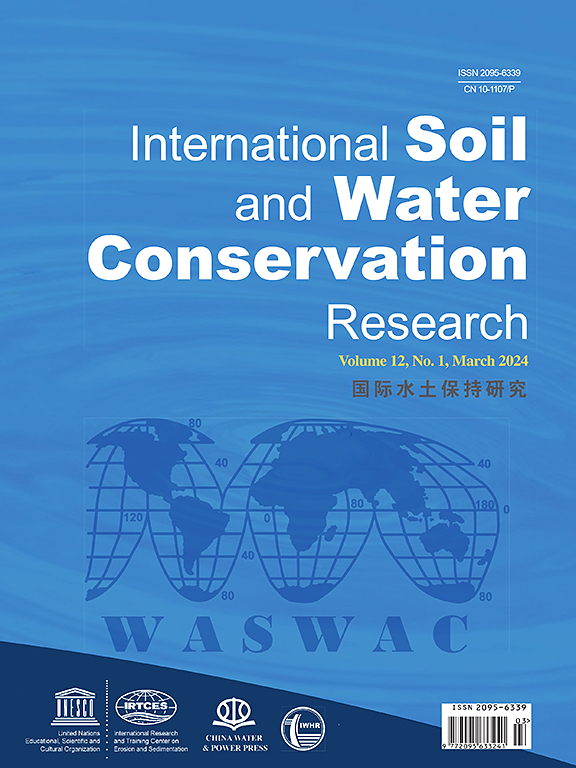开发基于网络的决策支持工具,用于使用高分辨率降雨数据和简化模型估算降雨侵蚀力
IF 7.3
1区 农林科学
Q1 ENVIRONMENTAL SCIENCES
International Soil and Water Conservation Research
Pub Date : 2025-03-17
DOI:10.1016/j.iswcr.2025.03.003
引用次数: 0
摘要
土壤侵蚀是一个重大的全球性问题,对农业生产力、环境健康和生态系统稳定有着深远的影响。通用土壤流失方程(USLE)中使用的降雨侵蚀因子(r因子)是预测土壤侵蚀的关键参数。然而,由于高分辨率降雨数据的复杂性和简化模型的局限性,对其进行精确估计是困难的。本研究通过引入几个关键创新来解决这些挑战。我们开发了一种精确的算法,用于使用分钟间隔降雨数据计算r因子,以有效地捕获评估极端降雨事件影响所需的时间分辨率。这一进步允许精确的r因子估计,从而克服了与高分辨率数据处理相关的复杂性。此外,我们还基于24年的分间隔降雨数据建立了韩国的综合降雨侵蚀力数据库。然后,我们推导了一个最优回归模型,用于从日降水数据估计月降雨侵蚀力,通过有效地考虑极端降雨事件,获得了较高的精度(R2 = 0.87)。这些努力最终导致了基于web的降雨侵蚀力计算(WREC)工具的开发,该工具集成了一个数据库、一个降雨侵蚀力计算算法和一个简单的估计模型。WREC工具的用户友好界面为计算降雨侵蚀力、支持实际应用和评估未来气候变化影响提供了一个多功能平台。在全球范围内扩大WREC工具,并根据当地情况调整回归模型,将增强我们管理土壤侵蚀和促进可持续土地和水管理做法的能力。本文章由计算机程序翻译,如有差异,请以英文原文为准。
Development of web-based decision support tool for rainfall erosivity estimation using both high-resolution rainfall data and simplified models
Soil erosion is a significant global problem that has far-reaching effects on agricultural productivity, environmental health, and ecosystem stability. The rainfall erosivity factor (R-factor) used in the Universal Soil Loss Equation (USLE) is a key parameter for predicting soil erosion. However, its accurate estimation is difficult owing to the complexities of high-resolution rainfall data and limitations of simplified models. This study addressed these challenges by introducing several key innovations. We developed a precise algorithm for calculating the R-factor using minute-interval rainfall data to effectively capture the necessary temporal resolution for assessing the impacts of extreme rainfall events. This advancement allows for accurate R-factor estimation, thereby overcoming the complexities associated with high-resolution data processing. In addition, we established a comprehensive rainfall erosivity database across South Korea based on 24 years of minute-interval rainfall data. We then derived an optimal regression model for estimating monthly rainfall erosivity from daily precipitation data, achieving high accuracy (R2 = 0.87) by effectively accounting for extreme rainfall events. These efforts culminated in the development of the Web-based Rainfall Erosivity Calculation (WREC) tool, which integrates a database, a rainfall erosivity calculation algorithm, and a simple estimation model. The user-friendly interface of the WREC tool offers a versatile platform for calculating rainfall erosivity, supporting practical applications, and assessing future climate change impacts. Expanding the WREC tool globally and adapting regression models to local contexts will enhance our ability to manage soil erosion and promote sustainable land and water management practices.
求助全文
通过发布文献求助,成功后即可免费获取论文全文。
去求助
来源期刊

International Soil and Water Conservation Research
Agricultural and Biological Sciences-Agronomy and Crop Science
CiteScore
12.00
自引率
3.10%
发文量
171
审稿时长
49 days
期刊介绍:
The International Soil and Water Conservation Research (ISWCR), the official journal of World Association of Soil and Water Conservation (WASWAC) http://www.waswac.org, is a multidisciplinary journal of soil and water conservation research, practice, policy, and perspectives. It aims to disseminate new knowledge and promote the practice of soil and water conservation.
The scope of International Soil and Water Conservation Research includes research, strategies, and technologies for prediction, prevention, and protection of soil and water resources. It deals with identification, characterization, and modeling; dynamic monitoring and evaluation; assessment and management of conservation practice and creation and implementation of quality standards.
Examples of appropriate topical areas include (but are not limited to):
• Conservation models, tools, and technologies
• Conservation agricultural
• Soil health resources, indicators, assessment, and management
• Land degradation
• Sustainable development
• Soil erosion and its control
• Soil erosion processes
• Water resources assessment and management
• Watershed management
• Soil erosion models
• Literature review on topics related soil and water conservation research
 求助内容:
求助内容: 应助结果提醒方式:
应助结果提醒方式:


